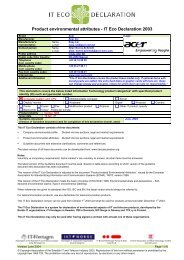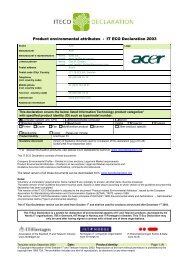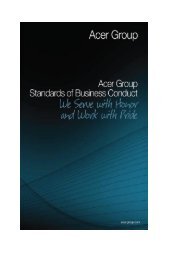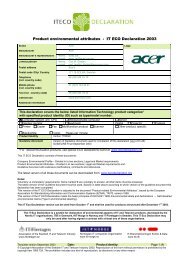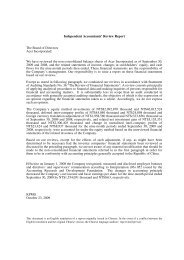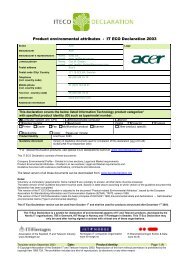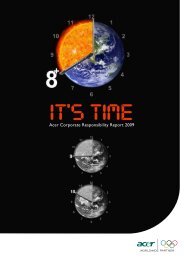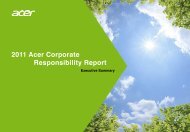Consolidated Financial Statements - Acer Group
Consolidated Financial Statements - Acer Group
Consolidated Financial Statements - Acer Group
You also want an ePaper? Increase the reach of your titles
YUMPU automatically turns print PDFs into web optimized ePapers that Google loves.
61ACER INCORPORATED AND SUBSIDIARIESNotes to <strong>Consolidated</strong> <strong>Financial</strong> <strong>Statements</strong> (continued)Investment PropertyClassifications ofdeferred income taxasset/liability andvaluation allowanceOverseas ConvertibleBonds (ECB)Investment inAssociatesUnder IFRSs, the Company should apply IAS 40 “Investment Property”for a property held to earn rental income or for capital appreciation.However, under R.O.C. GAAP, there is no specific guidance oninvestment property.1. Under R.O.C. GAAP, a deferred tax asset or liability is classified ascurrent or non-current in accordance with the classification of itsrelated asset or liability. If the deferred income tax asset or liability isnot directly related to a specific asset or liability, then theclassification is based on the asset‟s or liability‟s expected realizationdate. Under IFRSs, a deferred tax asset or liability is classified asnon-current asset or liability.2. Under R.O.C. GAAP, valuation allowances are provided to theextent, if any, that it is more likely than not that deferred income taxassets will not be realized. Under IFRSs, deferred tax assets are onlyrecognized to the extent that it is probable that there will besufficient taxable profits and the valuation allowance account is nolonger used.The ECB denominated in foreign currency grants an option to thebondholder to convert a fixed number of bonds into a fixed number ofthe Company‟s common shares, using a conversion price set at NewTaiwan Dollars at a fixed exchange rate. Accordingly, the conversionoption is accounted for as an equity under ROC GAAP. However, inaccordance with FAS 32, the conversion option is accounted for as aliability as the Company has a contractual obligation to deliver a fixednumber of common shares in exchange for a variable amount of cash(fixed foreign currency but translated to variable functional currency ofthe Company).1. Changes in ownership percentageUnder R.O.C. GAAP, if an investee company issues new shares andthe Company does not acquire new shares in proportion to itsoriginal ownership percentage, the Company‟s equity in theinvestee‟s net assets will change. The change in the equity interest isadjusted through the capital surplus or retained earnings. However,under IFRSs, the change in the equity interest is recognized in theprofit of loss in the case of decrease of ownership percentage whilethe partial step-up approach is applied in the case of increase ofownership percentage.2. Loss of significant influenceIn accordance with R.O.C. GAAP, when an entity loses significantinfluence over the investees, the adoption of equity method isdiscontinued and the carrying amount of the investment is deemed asthe new cost of the investment. However, under IFRSs, the loss ofsignificant influence is deemed as disposal of the investment andtherefore the disposal gain or loss is recognized thereon.(Continued)



